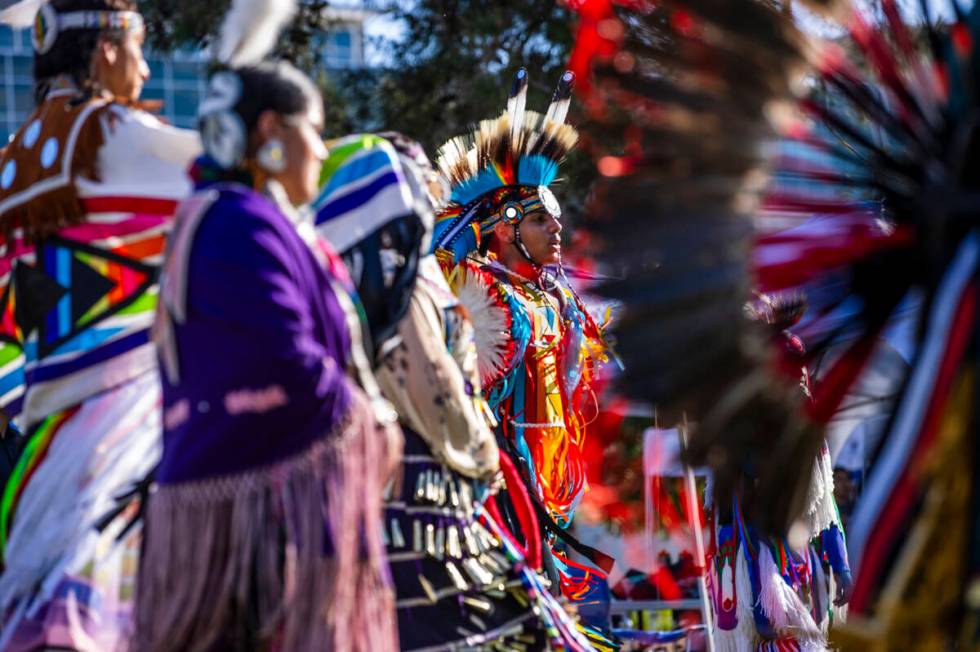‘We’re still here’: Native pride flashes at UNLV powwow — PHOTOS

The brown and white feathers on top of Ethan Hunt’s head weren’t just a part of his powwow outfit — they’re meant to symbolize a prairie chicken, found in the heartland of Blackfoot tribal territory.
On Friday, Hunt performed a “chicken dance,” an imitation of the prairie chicken’s bold mating movements. Male chickens court prospective mates by showing off, puffing out their chests and fanning their feathers.
“The whole goal is to kind of be a little flashier, a little flirtatious,” Hunt said.
Hunt, 24, was one of about a dozen Native Americans who dressed up for UNLV’s Powwow for the Planet, a two-day event in celebration of Earth Day that helps promote the visibility of tribes in Nevada and the West. UNLV’s land — and the greater Las Vegas Valley — once belonged to the Southern Paiutes, or Nuwuvi, who once roamed Southeastern California, Southern Nevada, Northern Arizona and Southern Utah.
Before moving to Las Vegas to study physical therapy at UNLV, Hunt said he grew up on the Pyramid Lake Paiute reservation north of Reno. He’s danced in powwows since he was 3 and said he finds them to be a special way to connect with his culture.
“It preserves tradition and helps people never forget that we’re still here,” Hunt said.
A chance to unite
About 200 people came to the first day of the powwow, including Assemblyman Howard Watts, D-Las Vegas, and non-Native people who were welcomed guests. There are five larger groups that Nevada’s tribes fall under, and powwows are something every tribe in North America have in common.
“We all have our individual cultures, traditions and language, but powwow is an opportunity for us to come together,” said Richard Savage, the Clark County School District’s Indian education coordinator who helped organize the event.
Savage said part of the mission is to promote cultural sites that tribes are calling to become protected national monuments. It used to be Avi Kwa Ame, a site that President Biden officially recognized last year.
This time, there are three sites organizers wanted to support — Bahsahwahbee in White Pine County, an area of East Las Vegas and the Ruby Mountains near Elko. This past week, three tribes met with Biden officials in the Department of Interior to discuss Bahsahwahbee, which tribal leaders say is the site of Western Shoshone massacres.
The event was a way for tribes to be visible not only to outsiders, but for Indigenous residents of the city who are trying to find community, Savage said.
“The purpose of powwow is to bring people together,” said Savage, who is of Southern Paiute descent.
Also on display Friday was Bernie Tallsalt’s handmade jewelry for sale, an artistic way that she connects with her Navajo culture.
For instance, her use of a turtle represents longevity and turquoise symbolizes success, said Tallsalt, who sells her creations across Arizona and the Southwest.
“To me, it means family,” she said. “And it’s a way to display your creations.”
The event will continue into Saturday from 11 a.m. to 5 p.m. on the lawn near UNLV’s Chemistry Building, where Las Vegas residents will keep learning about tribal issues and witnessing more colorful dancing.
Contact Alan Halaly at ahalaly@reviewjournal.com. Follow @AlanHalaly on X.